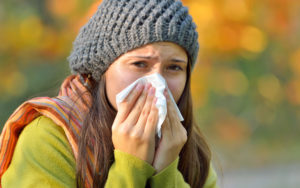August 18, 2015 | Black & Kletz Allergy

Ragweed is one of the several weeds that pollinate in late Summer and the early Fall. Seventeen different species of ragweed grow in the United States. Common ragweed grows up to five feet tall. It has hairy stems and light green leaves, up to four inches long. Ragweed grows in fields, gardens, and along roadsides. It is an annual plant, which means it only lives for one season.
Ragweed flowers are yellowish-green in color and small in size. They grow in clusters of up to six inches long near the top of the plant. Ragweed flowers produce large amounts of pollen. The pollen is transferred from one plant to another by the wind as well as insects.
Ragweed allergy occurs when an individual’s immune system produces a forceful response to a foreign substance (i.e., ragweed pollen) that is actually harmless in most circumstances. As a result, the individual experiences hay fever (allergic rhinitis), allergic conjunctivitis, and/or asthmasymptoms (see below).
Certain cells of the body begin releasing antibodies to proteins in the ragweed pollen. This results in the production of several chemicals (e.g., histamine) that cause these allergy symptoms. Some individuals with ragweed allergy may also get local itching of the mouth and throat areas when they eat fresh melons, bananas, kiwi, cucumbers, zucchini, and/or avocados. This condition is called oral allergy syndrome, which is also known as pollen-food allergy syndrome.
Each ragweed plant can release approximately one billion grains of ragweed pollen in one ragweed season. The grains are so light that the wind easily carries them into the air where individuals inhale the grains. The result is that these individuals may become sensitized and allergic to the ragweed pollen. The pollen travels very far by the wind and pollen has been detected hundreds of miles away. Some studies suggest that rising temperatures and carbon dioxide (CO2) levels are extending the ragweed season. In Northern Virginia and Washington, DC, ragweed begins to pollinate in mid-August, peaks after the Labor Day weekend in September, and lasts until the end of October when the first frost ultimately kills the plant.
What are the Symptoms?
The allergic reaction to all plants that produce pollen is commonly known as hay fever (allergic rhinitis). Symptoms can include itchy eyes, watery eyes, red eyes, puffy eyes, itchy nose, runny nose, stuffy nose, post-nasal drip, itchy throat, and sneezing. In those with severe allergies, asthma symptoms (i.e., wheezing, shortness of breath, cough, chest tightness), sinusitis, headaches, fatigue, and impaired sleep may also occur.
What Methods of Prevention are Recommended?
A few simple suggestions can dramatically diminish one’s exposure to pollen:
- It is preferable to stay inside when the pollen counts are at their highest. In the Washington, DC area, this is in the mid-morning and the mid-afternoon. One can track the pollen count in our area by clicking Today’s Pollen Count at the top of our website.
- After being outdoors, change your clothes after returning indoors and take a shower to remove the pollen. Do not hang clothes outdoors to dry, as the pollen will collect on them. Use a clothes dryer instead.
- Keep the windows closed in your car and home. Turn on the air conditioner. Make sure to change the air filters every 1-2 months.
- Shower before bed to remove pollen, especially from your face and hair.
- Use HEPA air filters in your home.
Diagnosing and Treating Ragweed Allergies:
When avoidance and prevention do not work, try over-the-counter medications. If symptoms continue, or complications arise, it may be time to seek the advice of a physician. The board certified allergists at Black & Kletz Allergy treat both adults and children with ragweed allergies and have done so for more than fifty years. A thorough history and physical examination will be performed and allergy skin testing and/or allergy blood testing can be done in order to diagnose your condition. Once a diagnosis of ragweed allergy is established, there are a multitude of medications available by prescription that can be tried in order to help alleviate your symptoms. These medications come in the form of pills, capsules, syrups, powders, nasal sprays, eye drops, and inhalers. Allergy shots (allergy immunotherapy, allergy injections) are an extremely effective means to treat not only ragweed allergy, but allergies (i.e., allergic rhinitis, allergic conjunctivitis, allergic asthma) in general. They work in approximately 80-85% of individuals, but take about 4-6 months before they are effective for most individuals. They have been around for over 100 years and can be given in children, adults, pregnant women, and the elderly with great success.
Black and Kletz Allergy has 3 convenient office locations in the Washington, DC, Northern Virginia, and Maryland metropolitan area. We have offices in Washington, DC, McLean, Virginia (Tysons Corner, Virginia), and Manassas, Virginia. The Washington, DC and McLean, VA offices are Metro accessible and all 3 locations offer on-site parking. The allergists and staff at Black and Kletz Allergy will gladly answer any of your questions or concerns. We strive to offer individualized treatment plans in order to alleviate your unwanted allergy symptoms in a caring and professional setting.












